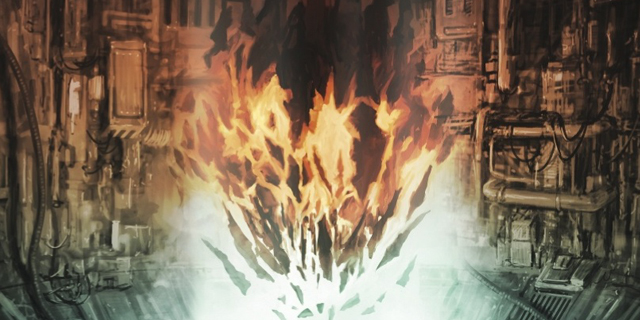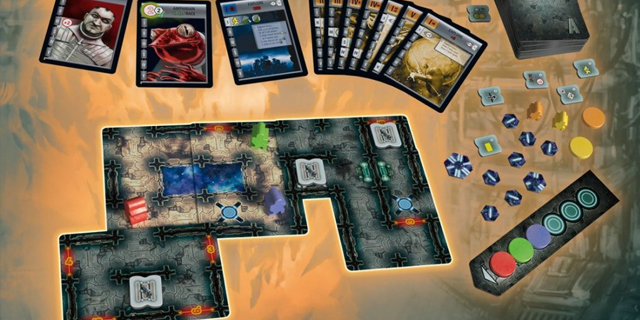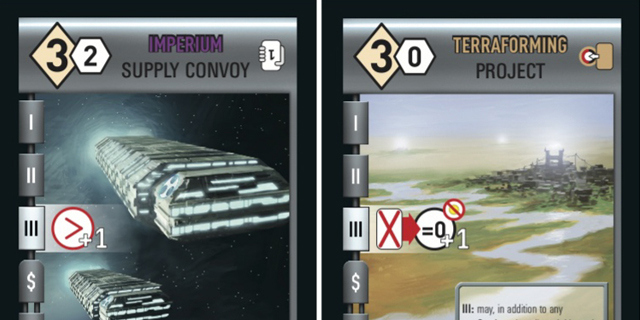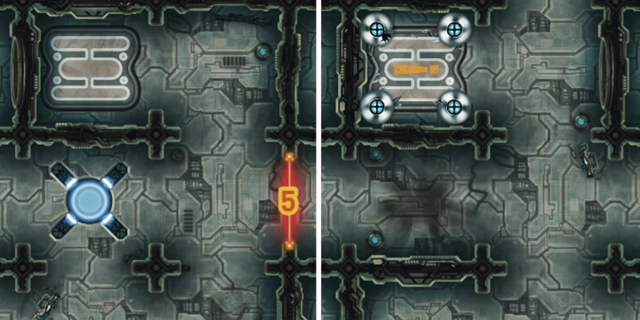
After a couple years of dormancy, Race for the Galaxy has re-emerged with a new expansion, Alien Artifacts. However, unlike most expansions, Alien Artifacts is the beginning of a new arc for Race, incompatible with the previous add-ons. Games played with Alien Artifacts will be played with just it and the original base set, providing a fresh new take on these now-classic cards — and a smaller deck to shuffle, which is always nice.
The titular alien artifact in question is known as the Orb, and exploring it literally adds a new dimension to Race gameplay, as a makeshift game board is now crafted out of special Orb cards. Each Orb card consists of six spaces and a variety of walls, barriers and other features. When placing a new card onto the existing Orb, there are a few of rules that must be followed: first, you cannot overlap an existing airlock space (just edges of an airlock card); second, you cannot place the new card on top of any player’s research team or any tokens that are present on the board; and third, any existing edges that overlap with the edge of the played card cannot be improved.
That last one needs a little more explaining, as it can be kind of confusing at first. Between any two given spaces on cards, there can either be an open passage, a laser barrier or a wall. When overlapping edge-on-edge, the border between the relevant spaces must be either the same or more difficult to pass. Open space must either remain open or become an obstacle, and barriers have to either remain the same or get stronger (higher-strength barrier or actual wall). Walls must stay walls.

As new cards are played, new artifact tokens are placed on designated spaces. These tokens can be retrieved by a player’s research team for points and possibly a one-time special ability. The abilities granted by these tokens vary, with some applicable to exploring the Orb and others helping you to develop your tableau.
The Orb itself is in addition to the regular Race gameplay, and that really hasn’t changed much other than the new cards. You still select one phase each turn, and still get a bonus for the phase you selected. The only difference is that whenever there is an Explore phase, players will first execute two of three possible Orb actions; if a player chose the Explore: Orb action, they will execute all three as their bonus.
The first action is to move your research team up to four spaces. Laser barriers can only be passed if you possess a sufficient military strength in your tableau (alien-specific military counts), but walls can only be bypassed using a token’s power. This movement can also include using teleporter icons to hop around from card to card, if available, but if a team moves onto an artifact token they claim it and forfeit the rest of their move, if any. Artifact tokens are kept secret until a player decides to use any ability it might have.
The second action is to play one of your Orb cards. Each player begins with three Orb cards in their hand, which neither count against their normal hand limit nor can be used for any tableau-related costs. Note that you can choose this action even if you have no Orb cards in hand, which will become relevant in a second.

The final Orb action is to draw a new Orb card. It is important to note that these actions must be executed in this order, so you cannot draw a new card and then play it. In addition to a tableau reaching twelve cards or the initial supply of victory point tokens being exhausted, drawing the final Orb card will also trigger the final round of play. Choosing to play a nonexistant card can prevent you from drawing this final card and ending the game if you don’t want it to end, although the opponents who act after you might not agree.
Race has always had a loose “turn order” based on the number of your starting world, but it was only really necessary in rare situations, such as when the deck was running low. Turn order is much more important when exploring the Orb, however, so Alien Artifacts includes a special indicator to keep track of this. Anyone playing an Explore: Orb card moves to the front of the line before actions are taken, as does anyone who chooses to pass instead of executing their two actions. Passing also lets you move your research team to any airlock space, which can be handy if they have become trapped by the ever-shifting walls or have exhausted their surroundings of artifacts.
While the option exists to play with just the new cards and ignore the Orb (and the few cards that reference it in their abilities), playing an “Orb game” is really the whole point of this expansion. It still feels like the Race we have all come to know, because for the most part it is. As I mentioned, the Orb adds a new dimension to play. You are no longer concerned with just your tableau, as the Orb is a shared space that can change without warning.

Speaking of space… wow, does the Orb take up a lot of it. In addition to each player’s tableau, the draw deck, discard pile, and VP pool of the normal game, the table now has to accommodate this constantly-expanding sprawl of overlapping cards, with its own draw deck and token pool. Even on the most generous gaming surfaces this can be taxing, and keeping everything within reach of everyone will get difficult quickly.
I still don’t know what to think of the “Orb game,” honestly. It almost adds too much. While The Brink of War added prestige, all that was at the end of the day was an additional set of VP tokens with a couple of simple new rules concerning them. This is so much more, like an entire subgame welded on to the core Race gameplay. The quick-playing simultaneous action is still there for every other phase, but extending every Explore phase into individual turns before heading into the simultaneous portion of the game adds up fast.
The best way to describe Alien Artifacts is “different.” Depending on the reason why you and your group like Race for the Galaxy, that “different” may or may not work for you. Never has “alien” been quite so appropriate a moniker.
Race for the Galaxy: Alien Artifacts retails for $25, although this does not include the temptation to purchase a fresh core set to go with it.



















